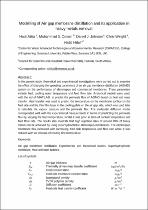 ResearchSpace
ResearchSpace
Modelling of air gap membrane distillation and its application in heavy metals removal
JavaScript is disabled for your browser. Some features of this site may not work without it.
- ResearchSpace
- →
- Research Publications/Outputs
- →
- Journal Articles
- →
- View Item
| dc.contributor.author |
Attia, H

|
|
| dc.contributor.author |
Osman, Muhammad S

|
|
| dc.contributor.author |
Johnson, DJ

|
|
| dc.contributor.author |
Wright, C

|
|
| dc.contributor.author |
Hilal, N

|
|
| dc.date.accessioned | 2018-01-25T12:21:13Z | |
| dc.date.available | 2018-01-25T12:21:13Z | |
| dc.date.issued | 2017-12 | |
| dc.identifier.citation | Attia, H. et al. 2017. Modelling of air gap membrane distillation and its application in heavy metals removal. Desalination, vol. 424: 27-37 | en_US |
| dc.identifier.issn | 0011-9164 | |
| dc.identifier.uri | https://www.sciencedirect.com/science/article/pii/S0011916417314807 | |
| dc.identifier.uri | https://doi.org/10.1016/j.desal.2017.09.027 | |
| dc.identifier.uri | http://hdl.handle.net/10204/9984 | |
| dc.description | Copyright: 2017 Elsevier. Due to copyright restrictions, the attached PDF file contains the preprint version of the published item. For access to the published version, please consult the publisher's website. | en_US |
| dc.description.abstract | In the present study, theoretical and experimental investigations were carried out to examine the effect of changing the operating parameters of an air gap membrane distillation (AGMD) system on the performance of electrospun and commercial membranes. These parameters include feed, cooling water temperature and feed flow rate. Analytical models were used, with the aid of MATLAB, to predict the permeate flux of AGMD based on heat and mass transfer. Heat transfer was used to predict the temperature on the membrane surface on the feed side and the thin film layer in the cooling plate on the air gap side, which was used later to calculate the vapour pressure and the permeate flux. The molecular diffusion model corresponded well with the experimental measurements in terms of predicting the permeate flux by varying the feed temperature, while it was poor in term of coolant temperature and feed flow rate. The results also illustrate that high rejection rates of around 99% of heavy metals can be achieved by using superhydrophobic electrospun membranes. The electrospun membrane flux increased with increasing feed tank temperature and flow rate while it was reduced with an increase of cooling line temperature. | en_US |
| dc.language.iso | en | en_US |
| dc.publisher | Elsevier | en_US |
| dc.relation.ispartofseries | Worklist;20085 | |
| dc.subject | Air gap membrane distillation | en_US |
| dc.subject | Experimental and theoretical studies | en_US |
| dc.subject | Heat and mass balance | en_US |
| dc.subject | Superhydrophobic membrane | en_US |
| dc.title | Modelling of air gap membrane distillation and its application in heavy metals removal | en_US |
| dc.type | Article | en_US |
| dc.identifier.apacitation | Attia, H., Osman, M. S., Johnson, D., Wright, C., & Hilal, N. (2017). Modelling of air gap membrane distillation and its application in heavy metals removal. http://hdl.handle.net/10204/9984 | en_ZA |
| dc.identifier.chicagocitation | Attia, H, Muhammad S Osman, DJ Johnson, C Wright, and N Hilal "Modelling of air gap membrane distillation and its application in heavy metals removal." (2017) http://hdl.handle.net/10204/9984 | en_ZA |
| dc.identifier.vancouvercitation | Attia H, Osman MS, Johnson D, Wright C, Hilal N. Modelling of air gap membrane distillation and its application in heavy metals removal. 2017; http://hdl.handle.net/10204/9984. | en_ZA |
| dc.identifier.ris | TY - Article AU - Attia, H AU - Osman, Muhammad S AU - Johnson, DJ AU - Wright, C AU - Hilal, N AB - In the present study, theoretical and experimental investigations were carried out to examine the effect of changing the operating parameters of an air gap membrane distillation (AGMD) system on the performance of electrospun and commercial membranes. These parameters include feed, cooling water temperature and feed flow rate. Analytical models were used, with the aid of MATLAB, to predict the permeate flux of AGMD based on heat and mass transfer. Heat transfer was used to predict the temperature on the membrane surface on the feed side and the thin film layer in the cooling plate on the air gap side, which was used later to calculate the vapour pressure and the permeate flux. The molecular diffusion model corresponded well with the experimental measurements in terms of predicting the permeate flux by varying the feed temperature, while it was poor in term of coolant temperature and feed flow rate. The results also illustrate that high rejection rates of around 99% of heavy metals can be achieved by using superhydrophobic electrospun membranes. The electrospun membrane flux increased with increasing feed tank temperature and flow rate while it was reduced with an increase of cooling line temperature. DA - 2017-12 DB - ResearchSpace DP - CSIR KW - Air gap membrane distillation KW - Experimental and theoretical studies KW - Heat and mass balance KW - Superhydrophobic membrane LK - https://researchspace.csir.co.za PY - 2017 SM - 0011-9164 T1 - Modelling of air gap membrane distillation and its application in heavy metals removal TI - Modelling of air gap membrane distillation and its application in heavy metals removal UR - http://hdl.handle.net/10204/9984 ER - | en_ZA |





